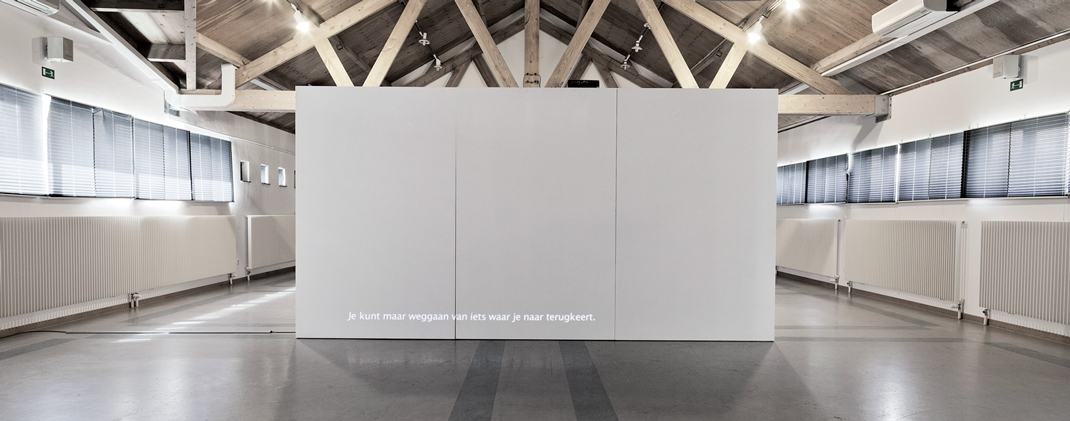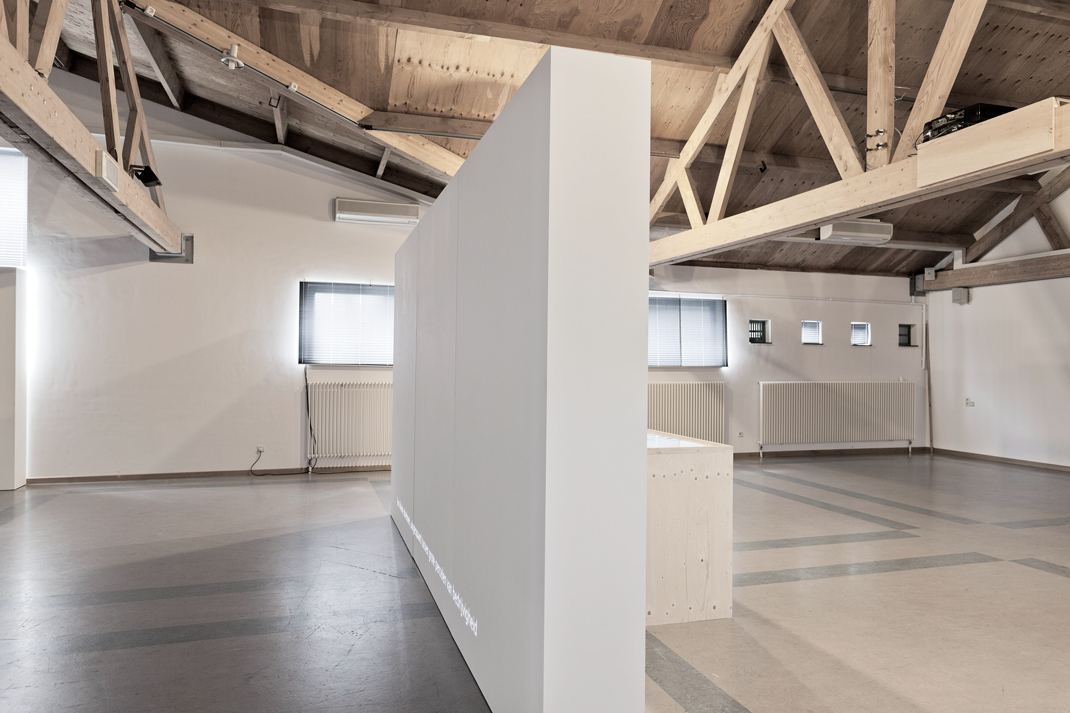2011, twofold installation
Text projection (‘recto’)
Video chronicle and photo archive (‘verso’)
Group exhibition at Nieuwevaart Ghent, May 2011
Group exhibition at DOK Ghent, Summer 2011
Solo exhibition at MIAT Museum Ghent, Summer 2012
Oceaniëstraat recto/verso is a twofold installation based on weekly interventions in Oceaniëstraat, Ghent. It was created within the context of an interdisciplinary research project at KASK School of Arts Ghent, focusing on “urban cracks”, in-between time spaces in the city.



Fragment of the video chronicle (‘verso’):
Full text projection (‘recto’):
(translation)
Maybe this is a sidetrack of the old railway system along the docks
like my interventions are only a sidetrack of the bigger picture.
To help
to dig out
to understand
how the/a context determines the/a content
how an intervention is read according to layers of meaning
visible and invisible.
« The camera is a pretext to gain access to this world
and learn about all these things. » (A.-M. Lê)
On satellite images of Google Earth you can see a curved track running through the grass
on the site behind the gated inlet on Oceaniëstraat.
I contact Pierre de Meyer.
He is an engineer at META, a non-profit organisation for mobility heritage.
He replies that these hidden tracks were probably part of port facilities
once connected to the railway system.
If you dig a little, you can measure the distance between the rails.
The gauge of tram tracks is 1 metre.
That of train tracks is 1.435 metres.
Just to be sure.
On Oceaniëstraat, the garbage truck must have passed by.
Besides a few empty cans, nothing else is left behind.
Here and there rusty tracks are sticking out of the ground.
The rail gauge measures 1.25 metres
?
Two days later I get a message from Georges Rogge.
Georges is Department Manager of General Affairs at NMBS, the Belgian railways.
He sends me a map of 1926 with railroad tracks of the neighbourhood.
A tangled web of branch lines that I cannot quite decipher.
Three days later I receive an e-mail from Luc Claerbout.
Luc is Chief Designer of the Technical Department at the port of Ghent.
He sends me two maps.
One dates back to 1947, when Oceaniëstraat was still called Europastraat.
(strange how these things change)
Along the docks stood a warehouse where wood was stacked
and in front of the inlet stood Stapelhuis Snauwaert
now a large vacant lot.
The second map dates from 1968.
The inlet was the entrance to the Filatures Gantoises Réunies
the umbrella company which included the old cotton mill of Braine-le-Chateau.
Around 1930 there were sixty-seven weaving mills
and twenty-eight spinning mills in Ghent, a.k.a. « Manchester of the continent ».
Braine-le-Chateau was one of them.
One of the « red factories ».
(red as in socialist)
The inlet on Oceaniëstraat was part of a shortcut from the docks to the cotton company
which stood approximately where the housing blocks of Scandinaviëstraat are located these days.
I wonder why the inlet is still here.
What once was a passageway, is now a ruled out remnant.
You can’t get in.
You can’t get out.
Is there even in and out ?
What lies behind the gate is just back out, a lawn, a closed clearing.
« I only see the outside. I notice.
What do you notice?
That any outside surrounded by another outside
becomes inside
and that any inside allowing an inside
changes into outside. » (A. Kristof)
I don’t live on Oceaniëstraat (as far as I know no one lives on Oceaniëstraat).
I don’t pass by daily, carrying groceries home, managing playing kids.
I only come here once or twice a week. From the outside.
I mean: literally.
I drive across town to get here.
Wondering how things would be now
what would have changed, who I would encounter.
I mean: I remain an outsider, looking at it and then leaving again.
Trying to gain access, one way or another.
watching searching watching trying
and trying again.
(deep zoom)
Hollow computer screens, looking like apartment blocks.
Is building towers out of dumping waste more than a futile attempt to structure this chaos?
Building anything with anything.
How unstable the structure is
although it stands no longer than one day
one day is longer than none.
Throughout the city, vacant voids are being filled with structures.
Is this a different design?
(I mean: no design at all.)
Starting from what is already there
creating new structures, entangled with the place
its history, its current use.
(a prediction for tomorrow)
Maybe that is the attractive thing about working with waste materials
because nobody has expectations.
If I get the old computer screens neatly in a row
the inlet could look at us
maybe not in a blaming or a reflecting way. Just as a point of view
but differently.
A language textbook, a puzzle, a hobby horse
puppets against the wall.
Pale green seat cushions as the front row
of this dumping ground scenography.
An invitation to look at what is present. And how it changes.
The inlet jumped out of all other places.
One of the smallest gaps I encountered in the area
intimate
manageable.
A small triangle cut out between large sites of productivity
inviting to be used
to leave something behind (that you no longer need)
to ask a question
to launch a proposal.
The inlet suggested something
something I’m still peeling off.
Architects would talk about the « genius loci » now.
They picked up this ancient Roman concept to highlight the specific character of a place.
Which soon became at odds with the destructive « tabula rasa ».
Like the billboard along the docks says
no spot can escape from it.
This historical icon
the yellow crane
will it still refer to the spirit of the old docks area
when the surrounding urban fabric is gone?
(I mean: the living fabric)
Who selects the icons?
What is to become a landmark
and what is to be ignored?
Do the housing blocks at Scandinaviëstraat just need a brighter colour?
How does a landmark differ from public art?
Should public art truly render the city more beautiful?
(than it really is)
Or more transparent?
(than it appears)
Back in Oceaniëstraat, there is a police car standing in front of the inlet.
The officer has found addresses in the dumped waste.
He advises me not to work here, because the smell is obnoxious.
Whether he has noticed that there are old tracks buried in the earth?
He hands me his card.
Sint-Amandsberg district police officer
We are responsible for this area.
I wonder what he means by we.
I wonder why police districts have different borders
and what this means (for him)
being responsible for an area.
I dig the earth, rake it fresh
after two hours, i write FREE on the wall.
The first word of a long sentence.
One week later, the waste has been collected, the tracks are still partly visible.
I write FEEL.
Walking down the street, I pass a giant truck
with a rotating engine and an open door (as a protective shield).
Oceaniëstraat seems to be the perfect pee break.
In the city archives I find a picture dating from the thirties.
Working men are rolling large poles into provisional woodpiles.
Open space as an antechamber for the industries.
« The inlet forces me not to think (or rather intuitive).
Intuition is a kind of thinking, it is not stupidity. » (J. Stockholder)
It is a pair of shoes
and another, and another.
It is a wooden board
from a child’s warderobe.
To construct a hiding-place
like the camps we used to build when we were little
but differently.
I continue (IN WHATEVER) but feel that someone is standing behind me.
He lives on the eleventh floor
in the blocks, yes.
He and his daughter will celebrate New Year’s Eve together again
like they always do, in her apartment on the ninth floor
out front. (the best view on the city’s fireworks)
– What does these words mean?
– Can you read them?
– Feel free to act and to proceed in whatever …
He says: you make.
I say: you do.
Then he continues on how much waste there is
how a few weeks back, they even dumped a bunch of computers.
I say: I know.
He says: I saw you.
– But what are you doing?
– I am building something.
– Is this for a project?
– Something like that, yes
a construction project.
Two more words.
That same land cruiser again, driving up and down the street
slowing down.
– What are you doing?
– I am writing words on a wall.
– Yes, but what do they mean?
– Can you read them?
(Haven’t I had this conversation already?)
– Those words in red are unreadable. Feel free to act …
He starts laughing.
When you write that, everyone thinks they can just continue dumping waste.
(No, I haven’t had this conversation yet.)
– Maybe, yes.
To me, it’s double.
I could add I (feel)
or you (feel).
He says: I hope it will rain soon, then your words will be erased.
I ask if he lives here.
He lives in the house on the corner.
The only resident of Oceaniëstraat.
He has lived here for forty years, but it has never been this bad.
It’s just one rotting mess.
Even when this was all industrial zone, it was cleaner than it is now.
When I ask his number, he says nothing at first and then he laughs
rather not
unless you plan to set this mess on fire
then you can always give me a call.
I remember
this is why I prefer the changing weathers over a warm studio.
Accidental discoveries
challenges
people crossing your path
pointing out how meaningful (-less) or provocative an act can be.
What you can or cannot do in public space.
How free you act-ually are.
The quote comes from a book on « spaces of incertainty ». (K. Cupers & M. Miessen)
Feel free to act and to proceed in whatever you do.
Removed out of the context of a theoretical book
inscribed into a specific space in the periphery of the city
its meaning becomes layered, loaded.
Week after week
the sentence develops.
Impulsive attempts and deliberate confrontations
creating insight into the complex and layered meanings of this gap
learning about the difference between beautiful plans for the future and a present on hold.
The difference also between reasonably interesting theories and the difficult translation into practice.
Repeated returns to the same place
create space
for unforeseen encounters.
How do others interpret this sentence?
How do they look at the inlet?
How free do they feel in the area
to do what they want?
Returning to the inlet to take a last picture, a man is looking for a new pair of shoes.
Reluctantly, I make him part of my last image.
« You can only get away from something you return to.
What you return to, is the place.
The place is the crack that links leaving and returning.
The place is the space of this turnabout.
Architecture knows this so well: therefore it makes corners.
Because in a circle, no turning is possible. » (D. Lauwaert)
The installation is documented in the book Reading urban cracks: Practices of artists and community workers (2012) where the text, originally displayed as a frame-by-frame projection, runs through all pages of the book.
This project was funded by the Research Fund University College Ghent.